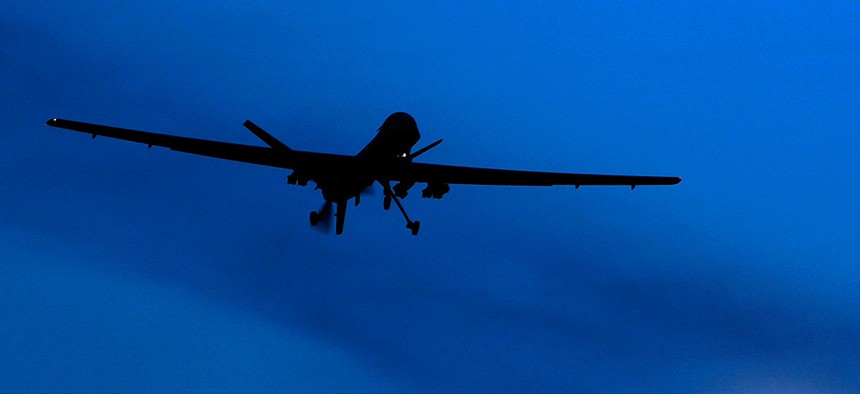
Kirsty Wigglesworth/AP file photo
Analysis: Giving the Deep State More Leeway to Kill With Drones
President Trump is poised to compound the most grave moral failing of his predecessor by making targeted killings less safe, less legal, and less rare.
The Trump administration believes that the targeted-killing policy of its predecessor is too restrictive, and officials intend to give what some call “the administrative state” and others call “the deep state” the ability to use lethal force with less oversight.
Expect more secretive killings by the CIA.
Former President Barack Obama presided over roughly 10 times as many lethal air strikes as George W. Bush in covert war-on-terror operations outside the war zones of Iraq and Afghanistan. The killings targeted terrorists belonging to groups like al-Qaeda and ISIS, as well as other militants that posed threats to allied regimes but not the United States.
American officials described those operations as “exceptionally surgical and precise,” as if innocent men, women, and children had nothing to fear from the strikes. But U.S. strikes in just three countries—Pakistan, Somalia, and Yemen—killed at least 384 innocent civilians and as many as 807, in addition to terrorists, according to a credible tally kept by the Bureau of Investigative Journalism. Put another way, attempts to preempt terrorism from those countries killed at least 128 times more innocents than the Boston Marathon bombing.
A surgeon as sloppy as that would be indicted.
The U.S. government has never explained how it calculates whether the cost of a given targeted killing outweighs the benefits. One wonders how many terrorists, or sworn enemies of America, are created on average when our drones kill an innocent. If the Pentagon or CIA has a working theory, official secrecy makes it impossible to vet.
On the other side of the ledger, al-Qaeda and ISIS kill far more civilians outside the United States than inside it. Some drone strikes surely spare more foreign innocents than they kill.
The trend of more secretive killings in successive presidencies will now continue. The Trump administration “is preparing to dismantle key Obama-era limits on drone strikes and commando raids outside conventional battlefields,” according to a New York Times article by Charlie Savage and Eric Schmitt, trusted bylines on this subject.
Two rule changes loom largest:
First, the targets of kill missions by the military and the C.I.A., now generally limited to high-level militants deemed to pose a “continuing and imminent threat” to Americans, would be expanded to include foot-soldier jihadists with no special skills or leadership roles. And second, proposed drone attacks and raids would no longer undergo high-level vetting.
The article adds that officials agree “they should keep in place one important constraint for such attacks: a requirement of ‘near certainty’ that no civilian bystanders will be killed.” What that constraint means in practice has long been unclear since civilian bystanders have, in fact, been killed every year it has been in place.
Given the horrific possibility of killing innocents and the risk of subsequent blowback, why would U.S. officials want to expand permissible targets from those who pose a “continuing or imminent threat” to Americans to “foot-soldier jihadists”?
Luke Hartig articulates the logic at Just Security:
Over 16 years of operations, our counterterrorism professionals have become adept at analyzing the structure of terrorist networks and targeting them based on the understanding that there are particular nodes that, if removed, could have a devastating impact on the entire network.
In many cases, those nodes may be couriers, bodyguards, or propagandists who, while lawful military targets under the laws of war, may not pose a continuing, imminent threat to U.S. persons. The new policy appears to give operators greater leeway to target according to what will be considerably more effective in disrupting and defeating terrorist networks. The challenge … will be establishing governing principles that limit the pace of strikes (as the continuing, imminent-threat standard did), since there are few countries outside of hot war zones that will give the U.S. blanket approvals for unfettered drone campaigns.
That logic is seductive but incomplete.
- It may sound like common sense to target “couriers, bodyguards, or propagandists” that are assisting al-Qaeda or ISIS. But consider how many innocents U.S. drone strikes killed when ostensibly targeting only “imminent” threats. As the number of targets increase, danger to innocents will, too.
- A thought experiment can make these trade-offs less abstract. Forget about Yemen, a country most Americans cannot begin to picture, and consider this truth: A propagandist for ISIS or al-Qaeda could conceivably live in the apartment or house next to yours. Or he could work next door to your child’s school. If that were the case, would you want the CIA to fire a Hellfire missile at him, knowing that neighboring buildings are sometimes struck and that innocents are sometimes killed? Americans accept “collateral damage,” including dead children, in Pakistan, Somalia, and Yemen that they would never tolerate in their own communities.
- Homegrown terrorism poses a much bigger risk to Americans than terrorists in Pakistan, Somalia, or Yemen. And an ongoing drone policy that kills lots of innocents abroad increases the likelihood that people here will become radicalized against the United States, as bygone terrorists who’ve cited such grievances illustrate.
- Drone strikes, especially those conducted in secret by the CIA, make it easier for elected and appointed elites to wage endless war all over the globe without securing the explicit permission of the people or even their representatives in Congress.
- The institutional player that would normally push back against the Pentagon and the CIA, the State Department, is presently less able to clarify the costs of excessively blowing people up for the president, because the president has failed to properly staff Foggy Bottom and seemingly doesn’t understand its purpose.
Al-Qaeda and ISIS are dangerous abominations. Fighting them is just, even if the fight involves the inadvertent killing of innocents, but only if due care is taken to avoid those deaths whenever possible. The entire history of the CIA suggests that it is not an organization one can trust to use lethal force with sufficient prudential and moral restraint, particularly when it needn’t risk its personnel or even public scrutiny to kill.
Obama’s inadequate safeguards guaranteed that U.S. policy on targeted killing would result in more dead innocents than was necessary to achieve like results. The Trump administration is poised to make changes that are even more hubristic and that guarantee even worse outcomes. What’s needed are more checks on killing, not fewer.







